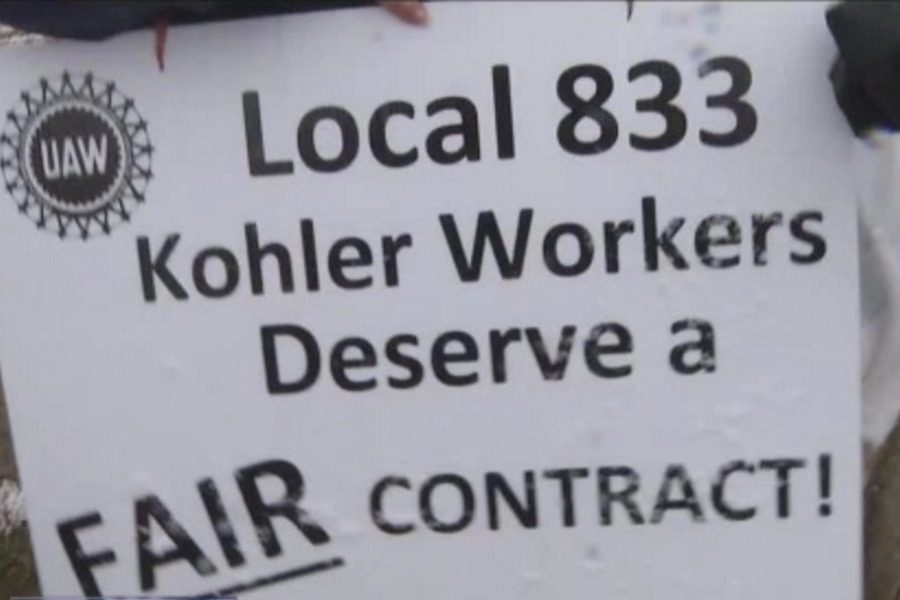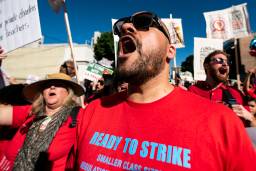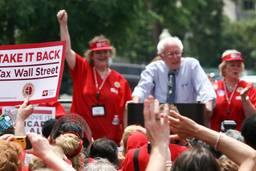Two thousand workers at the Kohler faucet plant in Wisconsin have been walking the picket since November 16. Such a strike would have been commonplace decades ago. Nowadays it is a rarity. Major strikes of over 1,000 workers are few and far between. Even rarer are open-ended strikes at an industrial plant.
Today’s battered labor movement no longer thinks of watershed strikes; we are so beaten down and used to defeat that no particular loss is seen as critical. And sadly, it’s not as if labor must win this particular battle to survive. The truth is labor has learned to live with defeat. But a more fundamental point is at stake: Labor must redevelop the ability to win this type of strike if we are to have any chance of survival.
The Kohler strike is an open-ended, large scale, non-publicity style strike in manufacturing, a traditionally organized industry. Labor has become adept at hit-and-run publicity strikes such as the Walmart, retail and fast food strikes of recent years. Although important, these are not the fight-to-the-finish type battles, nor do they involve anywhere near the number of workers or level of participation, that this strike does. It is likely that more days of work lost to striking have accumulated in two weeks of the Kohler strike than in five years of retail and fast food strike activity.
Decades ago, victory or at least a draw in such a strike would have been likely. Here we have a union, the United Auto Workers (UAW), with close to a century of unionism and a long history of confrontational class struggle. The strike involves almost 100% participation by the workers facing a historically anti-union corporation. Indeed, the Kohler plant was one of the most anti-union holdouts in the North at a time when most corporations operating in Northern and Midwestern states like Wisconsin temporarily accepted workers’ demands for unions and the right to strike.
The Kohler plant has a history of intense battles, including a 1934 strike which resulted in the formation of a company union. After the workers abandoned company unionism for the UAW, one of the longest strikes in U.S. history commenced in 1954. The strike in many ways was a dividing line between the mass militancy of the 1930s era and the modern era, which outlaws effective trade union activity. The strike produced picket line militancy, congressional hearings replete with conservative attacks on militancy, a Supreme Court case and finally a settlement in 1966 which kept the union intact. Unlike in many of today’s battles, the national UAW and AFL treated this is a key battle and helped sustain a national boycott of Kohler products for almost a decade. Despite the company’s vehement anti-unionism, the labor movement was able to fight the battle to a draw.
As recent as 20 or 30 years ago, progressives in the labor movement regarded strike solidarity as critical to labor’s success. The idea was that when a section of the working class went into an important battle, all of labor must view their victory as our highest priority. Battles such as the P9 strike at Hormel in Austin, Minnesota, the Detroit news strike and the Staley lockout drew support from thousands of trade unionists across the country who viewed those battles as their battles. Today, in contrast, when workers choose to fight, they often do so in isolation or with sporadic support from the entire labor movement.
Former ILWU longshore organizing director Peter Olney wrote a perceptive article a number of years ago which could have been written about the Kohler strike. Writing in the aftermath of the RIO Tinto lockout where workers employed massive solidarity to beat back an attack of unionism at a long-organized mine, Olney called for reviving the lost art of strike strategy. After detailing the many forgotten elements of such strategy, Olney concluded, “Perhaps most importantly, the labor movement has lost the concept of ‘swarming solidarity.’ Central labor bodies — once charged with mobilizing labor forces in their geographic areas in support of striking or locked-out workers — have become principally tasked with political action work.”
Olney pointed out that defensive battles like the Kohler strike are critical for the labor movement to win. “Every time these battles are lost, it sends out a widespread message that unions can’t defend their members and the union movement is dead. Conversely, when workers win these fights, confidence in labor grows and organizing becomes a bit easier because of the positive demonstration effect.” By this measure, the labor movement must rally behind the battle of the Kohler workers and view their victory as essential for the labor movement.
Yet victory is far from certain, for we have seen this script play itself over and over in the last three decades. A local union, tired of the unfair management’s relentless attacks, decides to take a stand. The courageous workers go out on strike with spirits high on the picket line. After some spirited picket line activity, the employer seeks and obtains and injunction against mass picketing. The union largely complies with this directive. The more enlightened unionists in the city and throughout the country help organize some sporadic solidarity rallies and holiday fundraising while most in labor goes about their business. The employer hires permanent replacement scabs, and production continues. The strike is eventually compromised or lost.
If labor is to not just survive but thrive, we must be able to change that story line — and win. That means concrete acts of solidarity such as resolutions of support, solidarity efforts and fundraising. But it should also mean that the labor movement begins to discuss what it means to break out of this cycle of losses — a cycle that is directly attributable to the rules of the game being fixed in capital’s favor. One hundred years ago, the AFL under Samuel Gompers’ leadership strategized about how to defy injunctions, as did a generation of trade unionists in the 1930s.
Labor developed a philosophy of defiance to unjust laws and promoted the right to an effective strike. Today’s national labor movement offers no such strategic guidance and is far more likely to counsel compliance with unjust labor laws.
In recent years, many in labor have become accustomed to highly choreographed strikes and well-scripted campaigns. All those things certainly have a place in the worker’s movement. Yet, real trade unionism based on local unions rooted in the workplace do not work that way. We don’t always get to pick the battles we support or the struggles that take place. But solidarity, and our survival of the labor movement, requires we support those increasingly rare instances when workers do choose to fight. The Wisconsin Kohler strike is exactly such a battle in need of such support.
Joe Burns, a former local union president active in strike solidarity, is a labor negotiator and attorney. He is the author of the book Reviving the Strike: How Working People Can Regain Power and Transform America (IG Publishing, 2011).







